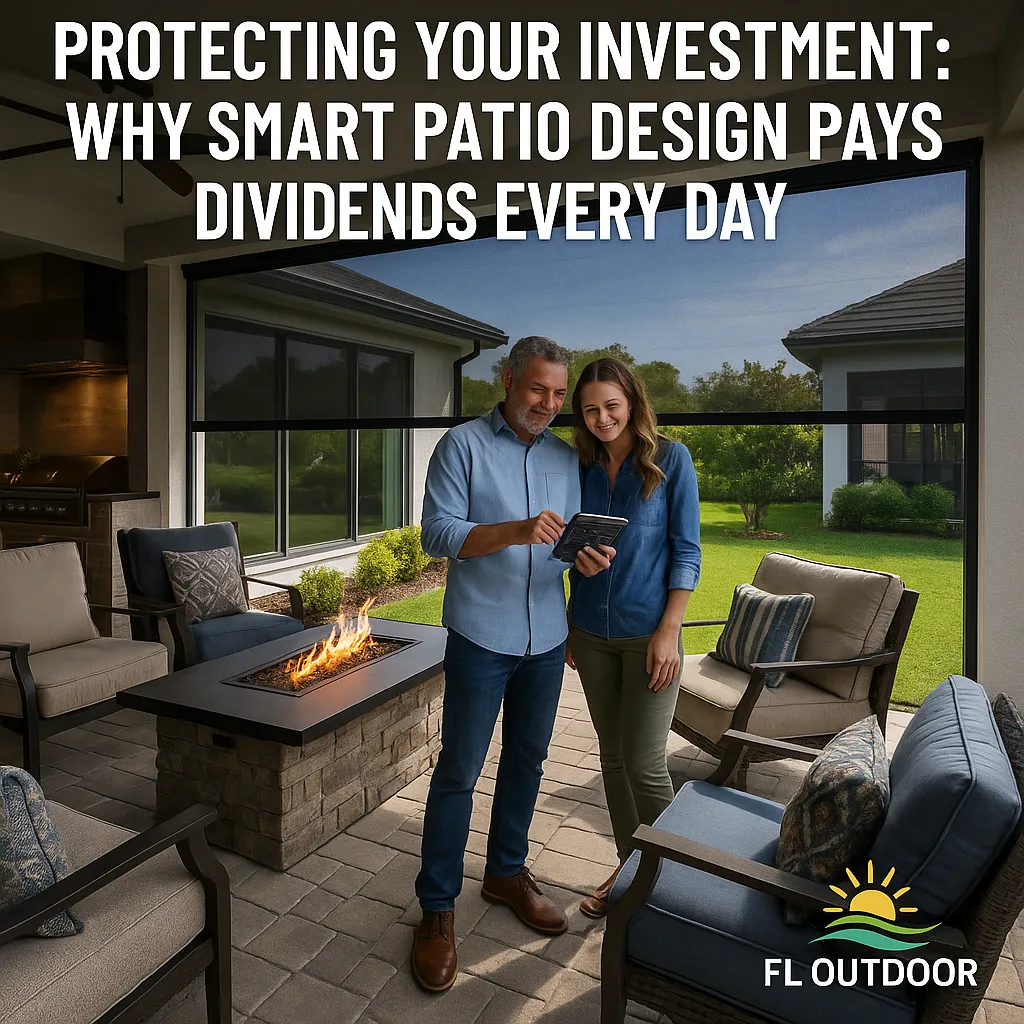
“Protecting Your Investment: Why Smart Patio Design Pays Dividends Every DayNew Blog Post
Tom and Maria didn’t need another lecture about “curb appeal.”
They needed a calculator.
They stood in their Fort Lauderdale backyard and did the math.
$42,000.
That’s what they’d poured into their outdoor space over five years. The patio, the kitchen, the fire feature. The cushions replaced every summer. The pest control bills. The storm repairs. The little purchases that felt harmless until they stacked into a mountain.
Forty-two thousand dollars. For a patio that sat mostly empty, used thirty days a year at best.
But six months ago, everything changed. They installed motorized screens. And suddenly, that same patio wasn’t draining them—it was paying them back.
Their story isn’t a one-off. It’s a warning. And it’s a roadmap. Because every homeowner eventually faces the same question:
Is your patio an asset—or a liability?
The Insurance Truth Nobody Tells You About Patios
Let’s start with what nobody wants to admit.
Your insurer looks at your patio the same way a gambler looks at a roulette wheel: risky, unpredictable, probably expensive.
That outdoor kitchen you brag about? It’s a “detached structure” in most policies. Coverage capped at 10%. If a storm takes it out, you’ll eat the difference.
But when your patio is protected—when those screens meet Miami-Dade hurricane codes—suddenly, you’re not a gambler anymore. You’re the house.
Wind mitigation credits slash Florida premiums 20–40% (floir.com). That’s $600–$1,200 saved every year on a $3,000 policy.
A single water damage claim averages $11,000 (iii.org). Avoid just one, and you’ve essentially bought your screens twice over.
Insurance isn’t about discounts. It’s about silence. Fewer claims. Fewer surprises. Lower risk. And silence, in this game, is golden.
Energy Efficiency Is a Wallet Issue, Not a Green Issue
Forget the marketing fluff. Energy savings aren’t about hugging trees. They’re about hugging your wallet.
Motorized solar screens slash cooling loads by 25–40% (energy.gov). For the average home, that’s $550–$880 saved annually. But it gets juicier.
Utilities charge triple during peak sun hours. Your patio bakes. Your AC strains. Your bill spikes. Screens block that heat before it hits, cutting peak use in half.
One Phoenix homeowner dropped 40% of peak-hour costs—over $1,100 a year. Add a $400 rebate from the utility, and they were net positive in the first year.
Scale that over twenty years with rate hikes: $30,000–$40,000 back in your pocket.
Call it what you want—sustainability, efficiency, common sense. We call it profit.
The Furniture Graveyard
Here’s the statistic no showroom shares: outdoor furniture dies 60% faster than indoor furniture.
The culprits? UV rays. Moisture. Temperature swings.
A $7,000 teak set looks timeless in the catalog. In real weather, it warps in 3–5 years. With screens? It lasts 15.
Cushions ($500–$1,000 per set) bleach and mold every summer. Protected, they last five.
Outdoor rugs ($200–$500) rot in a season. With screens, they thrive.
Tom and Maria once spent $1,500 a year on replacements. Now? $200. Screens didn’t just save money. They stopped the quiet grief of watching beautiful things decay.
Your patio can be a stage for memories—or a graveyard for furniture. Choose wisely.
The Time Tax Nobody Mentions
Here’s the cruelest cost of all: time.
3 hours storm prep.
2 hours storm cleanup.
8 hours seasonal storage.
30 minutes a week covering furniture.
A full weekend deep cleaning every year.
50 hours annually. 1,000 hours over 20 years.
That’s six months of full-time work lost to “patio chores.”
Screens erase 90% of it. That’s 900 hours returned. At $28/hour (the national median), that’s $25,000 worth of your life back.
But the truth is bigger than math. Those hours aren’t just “saved.” They’re traded up—into evenings with your kids, mornings with your spouse, weekends that feel like weekends again.
The Quality of Life ROI
This is where spreadsheets break down.
What’s the dollar value of:
A birthday party that isn’t rained out?
A quiet dinner without mosquitoes?
Holidays where nobody checks the weather app?
77% of homeowners underuse their patios (casualfurnishings.com). That’s not just wasted square footage. That’s wasted life.
Tom and Maria went from 30 days a year to 280. That’s 5,000 extra days over twenty years. At three hours each, that’s 15,000 hours of living outdoors.
Fifteen thousand hours of laughter, connection, presence. Try putting a price tag on that.
The Compound Effect
Protection multiplies value in ways homeowners rarely see:
Year 1: Energy + insurance = $1,800.
Year 2: Add furniture savings = $2,800.
Year 3: Add storm damage avoided = $4,300.
Year 5: Add property value = $7,000/year benefit.
Year 10: Add productivity + health = $10,000+/year.
By year ten, that $15,000 “expense” is returning 67% annually. Try asking Wall Street for those returns.
But the biggest compound effect isn’t money. It’s behavior. Protected patios get used. Used spaces get improved. Improved spaces build memories. And memories compound into a life well lived.
The Final Equation
So here’s the real math:
Unprotected patios = money lost, time wasted, life missed.
Protected patios = savings, safety, sanity, joy.
Tom and Maria’s payback period? 11.5 months.
But Tom said it best:
“The screens didn’t just protect our investment. They finally delivered the life we imagined.”
Your patio is either an asset or a liability. There is no middle ground.
The math is clear. The solution is proven. The only variable is you.
